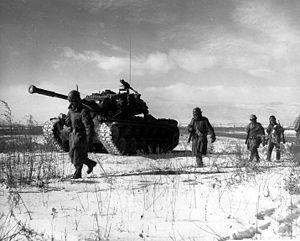Battle of Chosin Reservoir
The Battle of Chosin Reservoir (17 November – 13 December 1950) was an important battle during the Korean War.
The United Nations Command, led by the United States, occupied North Korea, which had attacked South Korea.
The People's Republic of China entered the war after it had given several warnings to the United Nations. It attacked United Nations Command and forced its retreat.
In 1953, the Korean War ended with a stalemate. An armistice divided Korea at the 38th parallel.
Background[change | change source]
North Korea invaded South Korea across the 38th parallel and occupied most of South Korea. The South Korean Army retreated to Busan.
The United Nations Command intervened, landed at Incheon, and captured Seoul. The United Nations occupied most of North Korea and approached its border with China, the Yalu River.
Chinese forces infiltrated into North Korea and hid there. Mao Zedong decided to attack the United Nations during the Second Phase Offensive.
Terrain[change | change source]
The Korean Peninsula has a mountain range, the Taebaek Mountains, in its middle that divides the east from the west. The Chosin Reservoir was an artificial lake in hilly terrain in the northeast of the peninsula. A road connects the reservoir to the southeast to the port city of Hungnam.
Aftermath[change | change source]
Despite their victory in the battle, the Chinese lost so many troops that they would not be able to win the war. Also, the United Nations learned lessons from the defeat and no longer had the effect of surprise.
Operation Glory occurred in 1954 to make permanent graveyards for those who had died during the battle.
References[change | change source]
- ↑ 1.0 1.1 1.2 1.3 1.4 Appleman, Roy (1990). Escaping the Trap: The US Army X Corps in Northeast Korea, 1950. Military History Series. Texas A&M University. ISBN 9780890963951.
- ↑ Xue & Li Part One 2000.
- ↑ 叶 2007, p. 259.
- ↑ 4.0 4.1 Xue & Li Part Four 2000.
- ↑ Roe, Patrick C. (2000). The Dragon Strikes: China and the Korean War, June–December 1950. Novato, California: Presidio Press. p. 394. ISBN 9780891417033.
- ↑ The 1st Marine Division reported 604 killed, 114 dead of wounds, 192 missing, 3,485 wounded and 7,338 non-battle casualties. However, US X Corps disputed the number by only recording 393 killed, 2,152 wounded and 76 missing for the 1st Marine Division. This number is calculated by inserting the 1st Marine Division's casualty data into the X Corps' total casualty report. See Appleman 1990, pp. 345–347 and Montross & Canzona 1992, pp. 381–382.
- ↑ This number is the total number of replacements requested by the 9th Army to reconstitute itself, which includes units that were not involved the fighting. See Roe 2000, p. 394.

